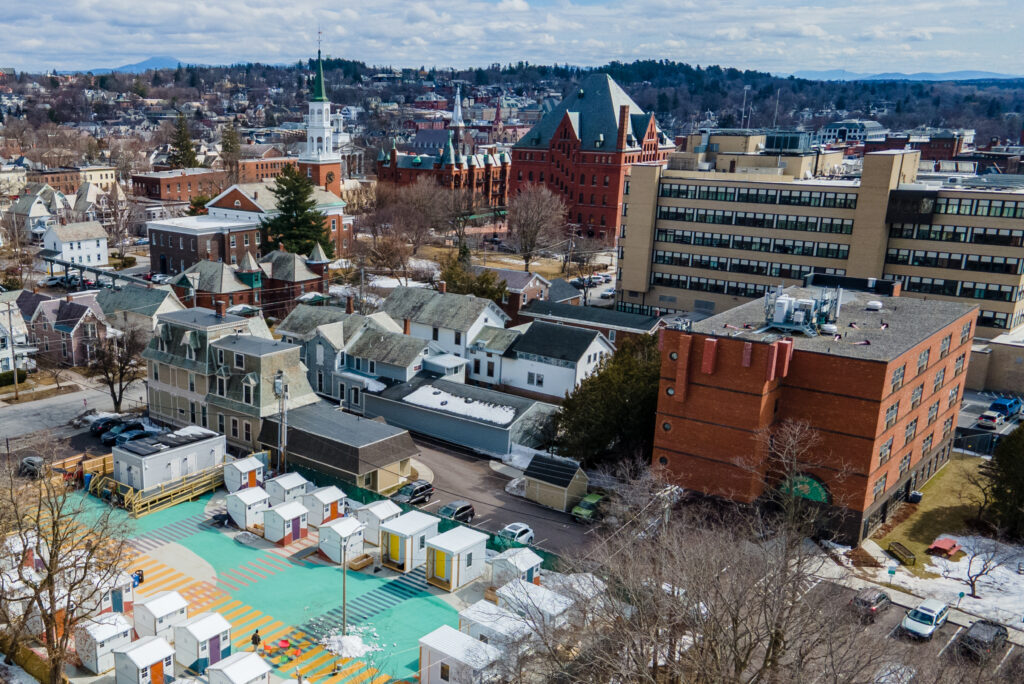3 Common Barriers to Opening a Pallet Shelter Village
November 9, 2023
Even while cities face challenges in opening new shelter villages, there are various methods to overcome them and aid vulnerable populations experiencing homelessness.

Many cities that aim to address their unsheltered homelessness crises see the benefits of interim shelter villages but face barriers in opening new sites. After encountering a wide variety of obstacles in our work with cities across the country, we can share our successes navigating these difficulties as a blueprint for any municipality aiming to provide equitable shelter for their vulnerable communities.
Whether it’s community opposition, trouble accessing funding, finding proper potential sites, or issues concerning infrastructure and zoning ordinances, our Community Development team is well-versed in finding tailored solutions for each city’s unique challenges.
We have found successful techniques to overcome many different barriers, but the following three arise the most frequently. Read on to learn how a diverse set of cities have succeeded in opening their own Pallet village despite adverse conditions.
Barrier 1: Accessing and Obtaining Funding
One of the first concerns that arises when considering building a Pallet shelter village is a simple question: how will we fund it?
Navigating funding options presents its own set of challenges, but we have seen villages built across the country utilizing a spectrum of different sources, from federal assistance programs to private donations. Some examples include:
- Federal Level Funding Sources
- American Rescue Plan Act (ARPA)
- Community Development Block Grants (CDBG)
- Home Investment Partnership Program (HOME)
- Local Municipality and State Government Funding
- State Funding
- County Auditor Funds
- City Funds
- Grants and Contributions from Private Sources
- Regional Housing Trusts
- Donations from private foundations, philanthropic organizations, corporations, and local donors
- Homeless Housing, Assistance, and Prevention Grant (HHAP)
While all of these are viable funding sources, we have also seen cities successfully combine funding from each level, and in the process, aid their unsheltered populations with appropriate urgency.
Barrier 2: Zoning and Land Use Challenges
Finding suitable and affordable land to build an interim shelter village can be a daunting task without assistance. But by working with local government boards, involving the community, and approaching land use challenges creatively, we have helped bring many Pallet shelter villages to life.
The following illustrate a few examples of how cities have overcome this specific barrier:
- Working with Legislature
One city sidestepped legal barriers by passing a city council vote to exempt a proposed site from specific building and zoning codes—while ensuring safety by working with the fire marshal during site development.
- Collaboration and Community Education
We witnessed a success story that involved creating an open forum composed of shelter organizations, community groups, landowners, and neighbors. By holding an open dialogue between all stakeholders in public meetings and coming to a solution that worked for everyone, the city was able to integrate a Pallet village into an existing residential neighborhood.
- Identifying Emergency Laws
Being aware of emergency land use laws has helped shelter communities develop over a significantly quicker timeline: by classifying unsheltered homelessness as the crisis that it is, we have seen cities provide essential shelter and supportive services with urgency.
- Creative Land Use
Creatively recategorizing property types has been another avenue of overcoming this particular barrier. One city even implemented a creative land classification to bring shelter and warmth to their unsheltered community right before the harsh cold of winter arrived.
While these solutions to these problems may not be self-evident, our Community Development team is adept and experienced in surmounting land use and zoning hurdles.
Barrier 3: Gaining Community Support
Community opposition often stands in the way of successfully building new shelter villages. We have found that by establishing an open line of communication between local governments and the public and providing education about the benefits of interim shelter, staunch opposition can often be transformed into outspoken support.
Some methods that have produced positive outcomes by engaging the community include:
- Alleviate concerns through education and disproving myths.
Common concerns surrounding new shelter villages are often based on the fear that these developments will increase crime and decrease neighboring property values. Providing facts to prove the opposite is true—such as data showing crime rates decreasing in areas surrounding new sites—can often spur a collective change of opinion.
- Host a village open house.
Demonstrating the inherent dignity and safety of Pallet villages has proven to be a boon to gaining community support: we have seen multiple cities host open houses where city leaders and heads of local organizations will stay in a shelter overnight to exhibit its potential in helping vulnerable people reintegrate and transition to permanent housing.
- Include the community in the decision-making process.
Ideas like creating a website to keep the public updated on crucial information and resources regarding a potential village or hosting community meetings that allow neighbors to voice their opinion has helped support efforts to develop new sites in various locations.
Interim shelter plays a crucial role in providing people with a stepping stone toward permanent housing, and examples like Pallet villages with onsite supportive services meet diverse needs of different displaced populations. And even while the model is proven to be an important part of resilient communities, city leaders are often impeded in the process.
Learn more about how Pallet’s Community Development team can help you maneuver barriers regarding funding, zoning and land use, and community opposition by reading our case studies.


